SpringBoot系列之Thymeleaf语法简单介绍
@
目录
- 1、模板引擎
- 2、Thymeleaf简介
- 2.1)、Thymeleaf定义
- 2.2)、适用模板
- 3、重要知识点
- 3.1)、th:text和th:utext
- 3.2)、标准表达式
Thymeleaf官方文档已经有比较详细的描述,所以本博客只挑部分比较重要的点看一下,还有介绍一下和SpringBoot怎么集成使用
1、模板引擎
引用百度百科的模板引擎解释:
模板引擎(这里特指用于Web开发的模板引擎)是为了使用户界面与业务数据(内容)分离而产生的,它可以生成特定格式的文档,用于网站的模板引擎就会生成一个标准的HTML文档。
在JavaEE领域有几中比较常用的模板引擎,分别是Jsp、Velocity、Freemarker、Thymeleaf,不过对于前端页面渲染效率来说,jsp其实还是最快的,Velocity次之。Thymeleaf虽然渲染效率不是很快,但是语法方面是比较轻巧的,Thymeleaf语法比Velocity轻巧,但是渲染效率不如Velocity
2、Thymeleaf简介
2.1)、Thymeleaf定义
Thymeleaf是适用于Web和独立环境的现代服务器端Java模板引擎,能够处理HTML,XML,JavaScript,CSS甚至纯文本。具体参考Thymeleaf官网
官网提供了在线文档也有文件格式的各种文档
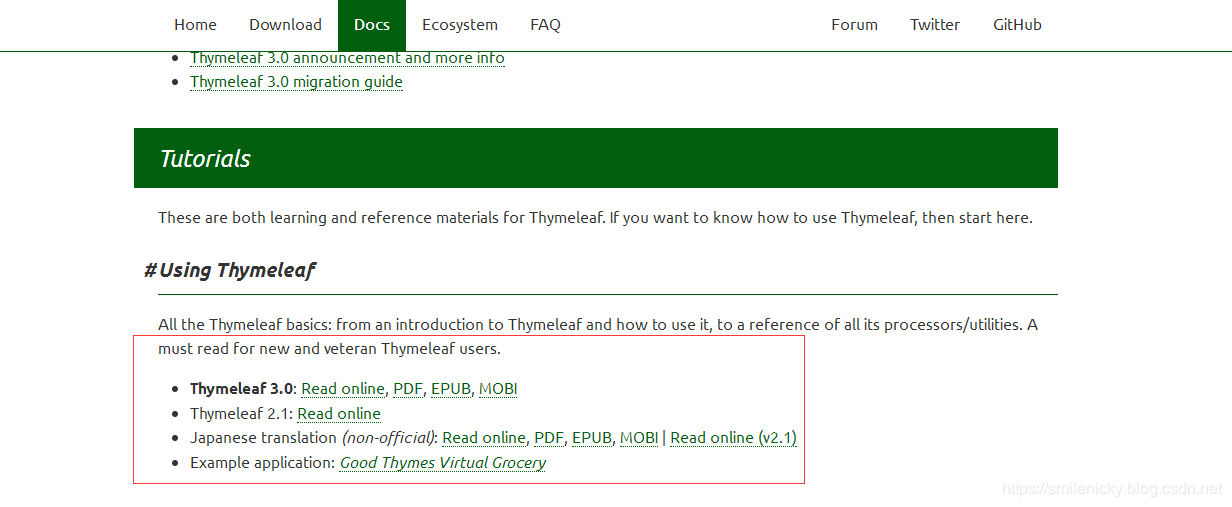
2.2)、适用模板
Thymeleaf适用于如下模板:
- HTML
- XML
- TEXT
- JAVASCRIPT
- CSS
- RAW
有两种标记模板模式(HTML 和 XML)、三种文本模板模式(TEXT、JAVASCRIPT 和 CSS)和一种无操作模板模式 (RAW)。
ok,下面给出一些比较重要的知识点
3、重要知识点
3.1)、th:text和th:utext
这是很常用的text标签,作用是Thymeleaf中设置文本的标签,分为两种,一种是th:text,另外一种是th:utext,两种最重要的区别就是会不会对特殊字符进行转义
- th:text:将所有特殊字符转成字符
- th:utext:不会将特殊字符进行字符转义
注意:这里的特殊字符主要指html标签,/n、/t、etc.这些字符是不支持的
写个例子对比一下:
<span th:text="${'Welcome to our <b>fantastic</b> grocery store!'}"></span><br/>
<span th:utext="${'Welcome to our <b>fantastic</b> grocery store!'}"></span>

3.2)、标准表达式
官方文档里有standard Expression Syntax这个章节,介绍的就是标准的表达式语法应用
- Simple expressions(简单表达式语法):
- Variable Expressions: ${…} // 获取遍历值,支持OGNL语法 etc.
- 获取自定义对象的属性值
- 获取自定义的变量属性值
- 使用内置的基本对象
- # ctx: the context object. #
- # vars: the context variables. #
- # locale: the context locale. #
- # request: (only in Web Contexts) the HttpServletRequest object. #
- # response: (only in Web Contexts) the HttpServletResponse object. #
- # session: (only in Web Contexts) the HttpSession object. #
- # servletContext: (only in Web Contexts) the ServletContext object. #
详情参考Thymeleaf的附录A
- 内置的工具类对象
官网已经给出比较详细的介绍,详细用法参考Thymeleaf附录B
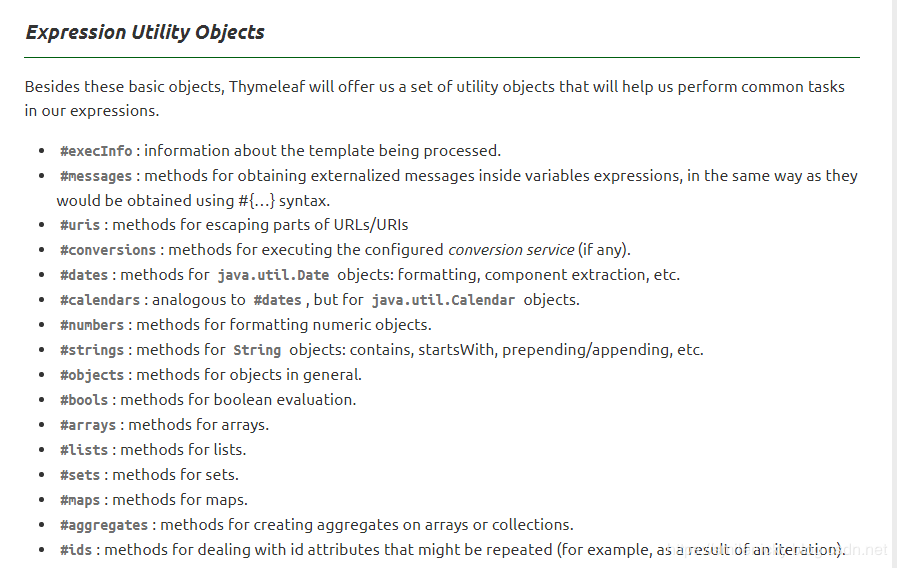
- Selection Variable Expressions: *{…} // 选定对象,也就是获取使用 th:object 属性的表达式的值
- Message Expressions: #{…} //国际化内容 详细用法参考我的博客: SpringBoot系列之i18n国际化多语言支持教程
- Link URL Expressions: @{…} // 定义URL链接
<link th:href="@{/static/css/public.css}" rel="stylesheet" type="text/css" />
<link th:href="@{/static/css/index.css}" rel="stylesheet" type="text/css" />
<script type="text/javascript" th:src="@{/static/js/jquery-1.3.2.min.js}"></script>
<script type="text/javascript" th:src="@{/static/js/html5.js}"></script>
<script type="text/javascript" th:src="@{/static/js/popbox.js}"></script>
* Fragment Expressions: ~{...} //片段引用的表达式 eg: `<div th:insert="~{commons :: main}">....</div>`
-
Literals (字面量值)
- Text literals: ‘one text’, ‘Another one!’,…
- Number literals: 0, 34, 3.0, 12.3,…
- Boolean literals: true, false
- Null literal: null
- Literal tokens: one, sometext, main,…
- Text operations (文本操作):
- String concatenation: + //连接操作
@{url/}+${id} - Literal substitutions: |The name is ${name}| //字符串中使用
${name}变量值
- String concatenation: + //连接操作
- Arithmetic operations: (数学运算)
- Binary operators: +, -, *, /, %
- Minus sign (unary operator): –
- Boolean operations:(布尔运算)
- Binary operators: and, or
- Boolean negation (unary operator): !, not
- Comparisons and equality:(比较运算)
- Comparators: >, <, >=, <= (gt, lt, ge, le)
- Equality operators: ==, != (eq, ne)
- Conditional operators:(条件运算,包括三元运算符etc.)
- If-then: (if) ? (then)
- If-then-else: (if) ? (then) : (else)
- Default: (value) ?: (defaultvalue)
- Special tokens:(特殊的令牌,也就是使用No-Operatio)
- No-Operation: _
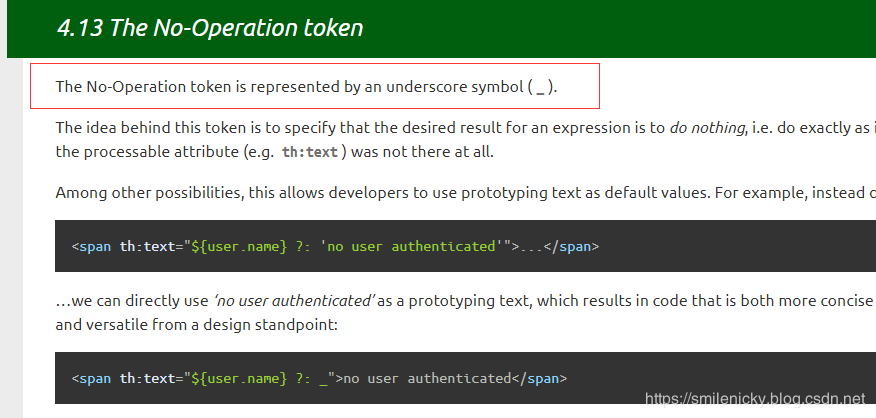
- No-Operation: _
All these features can be combined and neste:
'User is of type ' + (${user.isAdmin()} ? 'Administrator' : (${user.type} ?: 'Unknown'))
翻译过来意思是,这些语法都可以组合使用,这个章节是Thymeleaf一个重要的基本使用章节,本博客对一些重要的知识点进行摘录同时介绍一下在SpringBoot里如何使用,当然自然没有官方文档详细的,不过官方并没有通过中文文档,英文水平不好的话,阅读起来比较困难,当然我也找了一篇国内翻译过来的Thymeleaf中文文档,读者详细的可以参考文档
3.3)、Thymeleaf遍历
遍历是Thymeleaf很常用的例子,支持的属性值有:
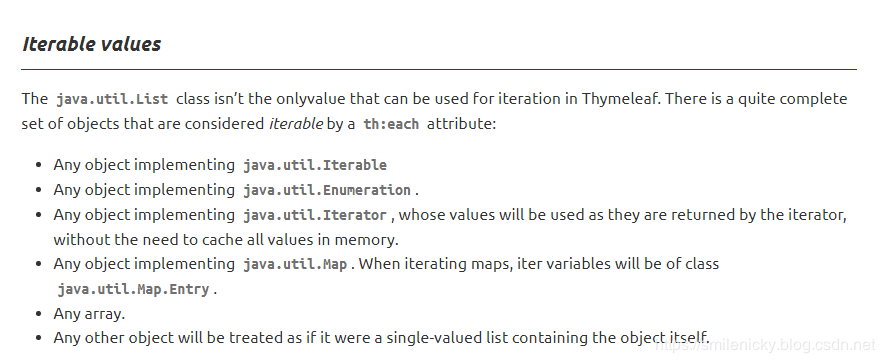
下面还是给下例子,比较容易理解,如下代码使用th:each,th:each="item : ${items}"
<!--最新上架-->
<div class="first-pannel clearfix">
<div class="index-f clearfix">
<h3 class="index-f-head"> 最新上架 <span>每天都有上新,每天都有惊喜</span> </h3>
<div class="index-f-body">
<div class="top-sales newProduct">
<ul class="top-sales-list clearfix">
<li class="top-sales-item newProduct" th:each="item : ${items}">
<p class="item-img"> <a th:href="@{'/portal/item/toDetail/'+${item.spuId}+'/'+${item.skuId}}"><img th:src="@{${item.imgPath}}" /></a> </p>
<p class="item-buss"><a th:href="@{'/portal/item/toDetail/'+${item.spuId}+'/'+${item.skuId}}"></a></p>
<p class="item-name spec"><a th:href="@{'/portal/item/toDetail/'+${item.spuId}+'/'+${item.skuId}}" th:text="${item.itemName}"></a></p>
<p class="item-price spec"><em th:text="${item.mPrice}"></em>元</p>
</li>
</ul>
</div>
</div>
</div>
</div>
<!--最新上架//-->
3.4)、公共模块抽取
在项目开发中经常遇到一些可以重用的页面,这时候就可以Thymeleaf的Template Layout进行公共页面的复用
本博客以官方介绍的复用footer.html页面进行说明
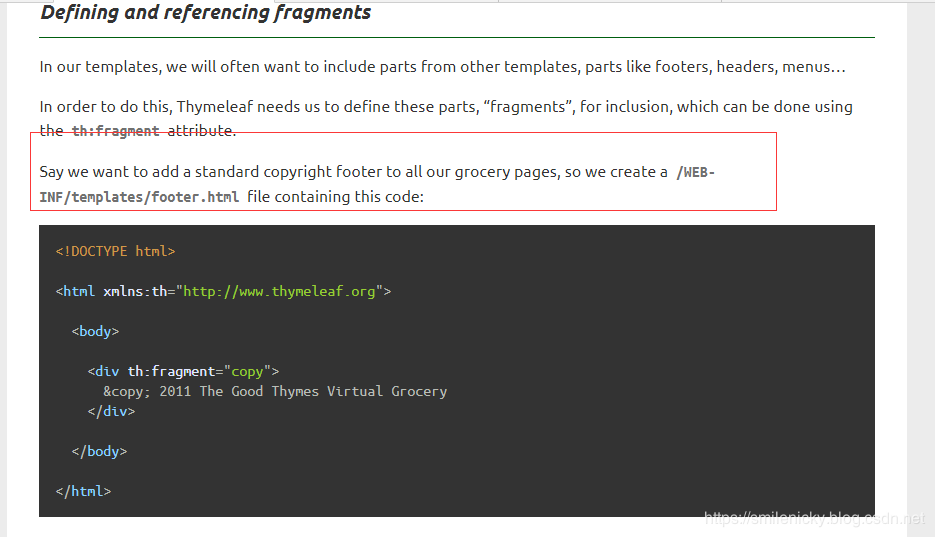
使用步骤:
1、 抽取公共的片段
<!DOCTYPE html>
<html xmlns:th="http://www.thymeleaf.org">
<body>
<div th:fragment="copy">
© 2011 The Good Thymes Virtual Grocery
</div>
</body>
</html>
1、 引入公共的片段
<div th:insert="~{footer :: copy}"></div>
~{templatename::selector}:模板名::选择器
~{templatename::fragmentname}:模板名::片段名
<div th:insert="footer :: copy"></div>
<div th:replace="footer :: copy"></div>
<div th:include="footer :: copy"></div
三种引入公共片段的th属性:
- th:insert:将公共片段整个插入到声明引入的元素中
- th:replace:将声明引入的元素替换为公共片段
- th:include:将被引入的片段的内容包含进这个标签中
效果对比:
<div>
<footer>
© 2011 The Good Thymes Virtual Grocery
</footer>
</div>
<footer>
© 2011 The Good Thymes Virtual Grocery
</footer>
<div>
© 2011 The Good Thymes Virtual Grocery
</div
3.5)、行内写法介绍
所谓行内写法就是没写在html对应的标签里的写法,直接在页面空白处,用[[….]]或者[(….)]的写法,然后[[….]]和[(….)]的区别其实就等同于th:text和th:utext的区别,一个会进行转义,一个不会转义特殊字符
- [[….]]写法:会转义html标签这些特殊字符(转成字符)
- [(….)]写法:不会转义html标签这些特殊字符(按照其原意)
写个例子就明白了:

<span>
The message is [[${msg}]]
</span>
<br/>
<span>
The message is [(${msg})]
</span>

3.6)、Thymeleaf语法规则
引用尚桂谷老师的归纳:
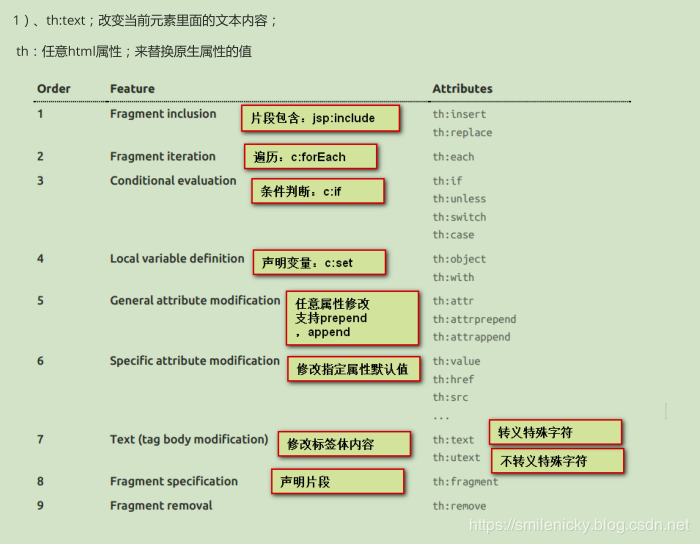
4、SpringBoot集成
4.1)、Springboot集成Thymeleaf简介
maven配置
因为引入了SpringBoot的parent工程,所以不需要写版本号
<!-- Themeleaf -->
<dependency>
<groupId>org.springframework.boot</groupId>
<artifactId>spring-boot-starter-thymeleaf</artifactId>
</dependency>
application.yml配置
注意:这里的属性大部分都可以不配置的,因为Springboot的自动配置因为做了很多自动配置,我们不配置,就使用默认的,不过下面的例子只是给读者了解一下有这些配置
#添加Thymeleaf配置,除了cache在项目没上线前建议关了,其它配置都可以不用配的,本博客只是列举一下有这些配置
thymeleaf:
# cache默认开启的,这里可以关了,项目上线之前,项目上线后可以开启
cache: false
# 这个prefix可以注释,因为默认就是templates的,您可以改成其它的自定义路径
prefix: classpath:/templates/
suffix: .html
mode: HTML5
# 指定一下编码为utf8
encoding: UTF-8
# context-type为text/html,也可以不指定,因为boot可以自动识别
content-type: text/html
ok,Springboot中Thymeleaf使用非常简单,因为Springboot已经为我们做了很多自动配置,其实,yaml都不需要配置的,直接引入对应的jar,然后就可以直接使用,在resources资源文件夹下面新建一个templates文件夹,所有的html文件都丢在这里,静态资源文件也丢在resources资源文件夹下面
新建一个html文件,然后注意加上<html xmlns:th="http://www.thymeleaf.org">
注意Thymeleaf语法要求比较严格 <meta charset="utf-8" >,不如这样写是不可以的,必须加上斜杠的,<meta charset="utf-8" />
<!DOCTYPE html>
<html lang="en" xmlns:th="http://www.thymeleaf.org">
<head>
<meta charset="UTF-8">
<title>Title</title>
</head>
<body>
<div>
<span th:text="${'Welcome to our <b>fantastic</b> grocery store!'}"></span><br/>
<span th:utext="${'Welcome to our <b>fantastic</b> grocery store!'}"></span>
</div>
<span>
The message is [[${msg}]]
</span>
<br/>
<span>
The message is [(${msg})]
</span>
</body>
</html>
4.2)、Thymeleaf自动配置源码简单分析
ok,然后为什么我说直接引入对应pom配置就可以直接使用了?因为Springboot已经为项目做了很多自动配置,所以本博客简单跟一下源码,了解一下SpringbootThymeleaf的自动配置
SpringBoot的自动配置类在ThymeleafAutoConfiguration里
package org.springframework.boot.autoconfigure.thymeleaf;
....
@Configuration(proxyBeanMethods = false)//定义这是一个配置类
@EnableConfigurationProperties(ThymeleafProperties.class)//使用ThymeleafProperties属性类的属性
@ConditionalOnClass({ TemplateMode.class, SpringTemplateEngine.class })//指定TemplateMode、SpringTemplateEngine(模板引擎类)起效的情况,整个配置类才起作用
@AutoConfigureAfter({ WebMvcAutoConfiguration.class, WebFluxAutoConfiguration.class })//必须在WebMvcAutoConfiguration(SpringMVC自动配置类,这个配置类会加载组装所有的视图解析器)、WebFluxAutoConfiguration类起效后,这个Thymeleaf自动配置类才起效
public class ThymeleafAutoConfiguration {
//没有自定义的模板解析器类的情况,使用默认的模板解析器
@Configuration(proxyBeanMethods = false)
@ConditionalOnMissingBean(name = "defaultTemplateResolver")
static class DefaultTemplateResolverConfiguration {
private static final Log logger = LogFactory.getLog(DefaultTemplateResolverConfiguration.class);
//Thymeleaf的properties配置
private final ThymeleafProperties properties;
private final ApplicationContext applicationContext;
DefaultTemplateResolverConfiguration(ThymeleafProperties properties, ApplicationContext applicationContext) {
this.properties = properties;
this.applicationContext = applicationContext;
}
//用PostConstruct注解,在依赖注入完成之后,实现类的初始化配置,这个方法主要是检查模板引擎的资源文件路径是否有
@PostConstruct
void checkTemplateLocationExists() {
boolean checkTemplateLocation = this.properties.isCheckTemplateLocation();
if (checkTemplateLocation) {
TemplateLocation location = new TemplateLocation(this.properties.getPrefix());
if (!location.exists(this.applicationContext)) {
logger.warn("Cannot find template location: " + location + " (please add some templates or check "
+ "your Thymeleaf configuration)");
}
}
}
//默认的Thymeleaf资源解析器
@Bean
SpringResourceTemplateResolver defaultTemplateResolver() {
SpringResourceTemplateResolver resolver = new SpringResourceTemplateResolver();
//资源解析器的所有配置
resolver.setApplicationContext(this.applicationContext);
resolver.setPrefix(this.properties.getPrefix());
resolver.setSuffix(this.properties.getSuffix());
resolver.setTemplateMode(this.properties.getMode());
if (this.properties.getEncoding() != null) {
resolver.setCharacterEncoding(this.properties.getEncoding().name());
}
resolver.setCacheable(this.properties.isCache());
Integer order = this.properties.getTemplateResolverOrder();
if (order != null) {
resolver.setOrder(order);
}
resolver.setCheckExistence(this.properties.isCheckTemplate());
return resolver;
}
}
//又是Thymeleaf的自动配置,自动配置模板引擎SpringTemplateEngine
@Configuration(proxyBeanMethods = false)
protected static class ThymeleafDefaultConfiguration {
@Bean
@ConditionalOnMissingBean(ISpringTemplateEngine.class)
SpringTemplateEngine templateEngine(ThymeleafProperties properties,
ObjectProvider<ITemplateResolver> templateResolvers, ObjectProvider<IDialect> dialects) {
SpringTemplateEngine engine = new SpringTemplateEngine();
engine.setEnableSpringELCompiler(properties.isEnableSpringElCompiler());
engine.setRenderHiddenMarkersBeforeCheckboxes(properties.isRenderHiddenMarkersBeforeCheckboxes());
templateResolvers.orderedStream().forEach(engine::addTemplateResolver);
dialects.orderedStream().forEach(engine::addDialect);
return engine;
}
}
@Configuration(proxyBeanMethods = false)
@ConditionalOnWebApplication(type = Type.SERVLET)
@ConditionalOnProperty(name = "spring.thymeleaf.enabled", matchIfMissing = true)
static class ThymeleafWebMvcConfiguration {
@Bean
@ConditionalOnEnabledResourceChain
@ConditionalOnMissingFilterBean(ResourceUrlEncodingFilter.class)
FilterRegistrationBean<ResourceUrlEncodingFilter> resourceUrlEncodingFilter() {
FilterRegistrationBean<ResourceUrlEncodingFilter> registration = new FilterRegistrationBean<>(
new ResourceUrlEncodingFilter());
registration.setDispatcherTypes(DispatcherType.REQUEST, DispatcherType.ERROR);
return registration;
}
//比较重要的视图解析器配置
@Configuration(proxyBeanMethods = false)
static class ThymeleafViewResolverConfiguration {
@Bean
@ConditionalOnMissingBean(name = "thymeleafViewResolver")
ThymeleafViewResolver thymeleafViewResolver(ThymeleafProperties properties,
SpringTemplateEngine templateEngine) {
ThymeleafViewResolver resolver = new ThymeleafViewResolver();
//设置模板引擎
resolver.setTemplateEngine(templateEngine);
//字符编码设置
resolver.setCharacterEncoding(properties.getEncoding().name());
resolver.setContentType(
appendCharset(properties.getServlet().getContentType(), resolver.getCharacterEncoding()));
resolver.setProducePartialOutputWhileProcessing(
properties.getServlet().isProducePartialOutputWhileProcessing());
resolver.setExcludedViewNames(properties.getExcludedViewNames());
resolver.setViewNames(properties.getViewNames());
// This resolver acts as a fallback resolver (e.g. like a
// InternalResourceViewResolver) so it needs to have low precedence
resolver.setOrder(Ordered.LOWEST_PRECEDENCE - 5);
//Thymeleaf缓存
resolver.setCache(properties.isCache());
return resolver;
}
private String appendCharset(MimeType type, String charset) {
if (type.getCharset() != null) {
return type.toString();
}
LinkedHashMap<String, String> parameters = new LinkedHashMap<>();
parameters.put("charset", charset);
parameters.putAll(type.getParameters());
return new MimeType(type, parameters).toString();
}
}
}
@Configuration(proxyBeanMethods = false)
@ConditionalOnWebApplication(type = Type.REACTIVE)
@ConditionalOnProperty(name = "spring.thymeleaf.enabled", matchIfMissing = true)
static class ThymeleafReactiveConfiguration {
@Bean
@ConditionalOnMissingBean(ISpringWebFluxTemplateEngine.class)
SpringWebFluxTemplateEngine templateEngine(ThymeleafProperties properties,
ObjectProvider<ITemplateResolver> templateResolvers, ObjectProvider<IDialect> dialects) {
SpringWebFluxTemplateEngine engine = new SpringWebFluxTemplateEngine();
engine.setEnableSpringELCompiler(properties.isEnableSpringElCompiler());
engine.setRenderHiddenMarkersBeforeCheckboxes(properties.isRenderHiddenMarkersBeforeCheckboxes());
templateResolvers.orderedStream().forEach(engine::addTemplateResolver);
dialects.orderedStream().forEach(engine::addDialect);
return engine;
}
}
//ThymeleafWebFluxConfiguration自动配置
@Configuration(proxyBeanMethods = false)
@ConditionalOnWebApplication(type = Type.REACTIVE)
@ConditionalOnProperty(name = "spring.thymeleaf.enabled", matchIfMissing = true)
static class ThymeleafWebFluxConfiguration {
@Bean
@ConditionalOnMissingBean(name = "thymeleafReactiveViewResolver")
ThymeleafReactiveViewResolver thymeleafViewResolver(ISpringWebFluxTemplateEngine templateEngine,
ThymeleafProperties properties) {
ThymeleafReactiveViewResolver resolver = new ThymeleafReactiveViewResolver();
resolver.setTemplateEngine(templateEngine);
mapProperties(properties, resolver);
mapReactiveProperties(properties.getReactive(), resolver);
// This resolver acts as a fallback resolver (e.g. like a
// InternalResourceViewResolver) so it needs to have low precedence
resolver.setOrder(Ordered.LOWEST_PRECEDENCE - 5);
return resolver;
}
private void mapProperties(ThymeleafProperties properties, ThymeleafReactiveViewResolver resolver) {
PropertyMapper map = PropertyMapper.get();
map.from(properties::getEncoding).to(resolver::setDefaultCharset);
resolver.setExcludedViewNames(properties.getExcludedViewNames());
resolver.setViewNames(properties.getViewNames());
}
private void mapReactiveProperties(Reactive properties, ThymeleafReactiveViewResolver resolver) {
PropertyMapper map = PropertyMapper.get();
map.from(properties::getMediaTypes).whenNonNull().to(resolver::setSupportedMediaTypes);
map.from(properties::getMaxChunkSize).asInt(DataSize::toBytes).when((size) -> size > 0)
.to(resolver::setResponseMaxChunkSizeBytes);
map.from(properties::getFullModeViewNames).to(resolver::setFullModeViewNames);
map.from(properties::getChunkedModeViewNames).to(resolver::setChunkedModeViewNames);
}
}
@Configuration(proxyBeanMethods = false)
@ConditionalOnClass(LayoutDialect.class)
static class ThymeleafWebLayoutConfiguration {
@Bean
@ConditionalOnMissingBean
LayoutDialect layoutDialect() {
return new LayoutDialect();
}
}
@Configuration(proxyBeanMethods = false)
@ConditionalOnClass(DataAttributeDialect.class)
static class DataAttributeDialectConfiguration {
@Bean
@ConditionalOnMissingBean
DataAttributeDialect dialect() {
return new DataAttributeDialect();
}
}
@Configuration(proxyBeanMethods = false)
@ConditionalOnClass({ SpringSecurityDialect.class })
static class ThymeleafSecurityDialectConfiguration {
@Bean
@ConditionalOnMissingBean
SpringSecurityDialect securityDialect() {
return new SpringSecurityDialect();
}
}
@Configuration(proxyBeanMethods = false)
@ConditionalOnClass(Java8TimeDialect.class)
static class ThymeleafJava8TimeDialect {
@Bean
@ConditionalOnMissingBean
Java8TimeDialect java8TimeDialect() {
return new Java8TimeDialect();
}
}
}
ThymeleafProperties是SpringBoot的属性配置类,使用ConfigurationProperties注解进行属性映射
@ConfigurationProperties(prefix = "spring.thymeleaf")
public class ThymeleafProperties {
private static final Charset DEFAULT_ENCODING = StandardCharsets.UTF_8;
//默认的模板资源路径
public static final String DEFAULT_PREFIX = "classpath:/templates/";
//默认解析html资源
public static final String DEFAULT_SUFFIX = ".html";
/**
* Whether to check that the template exists before rendering it.
*/
private boolean checkTemplate = true;
/**
* Whether to check that the templates location exists.
*/
private boolean checkTemplateLocation = true;
/**
* Prefix that gets prepended to view names when building a URL.
*/
private String prefix = DEFAULT_PREFIX;
/**
* Suffix that gets appended to view names when building a URL.
*/
private String suffix = DEFAULT_SUFFIX;
/**
* Template mode to be applied to templates. See also Thymeleaf's TemplateMode enum.
*/
//默认模式也是html的
private String mode = "HTML";
/**
* Template files encoding.
*/
private Charset encoding = DEFAULT_ENCODING;
/**
* Whether to enable template caching.
*/
//默认开启缓存,项目没上线建议通过配置关闭,然后按F9就可以自动编译,避免影响调试
private boolean cache = true;
....
}
ok,然后简单跟一下视图解析器的源码:Thymeleaf视图解析器类的关键代码,创建视图view的方法,如图,也是根据viewname进行重定向
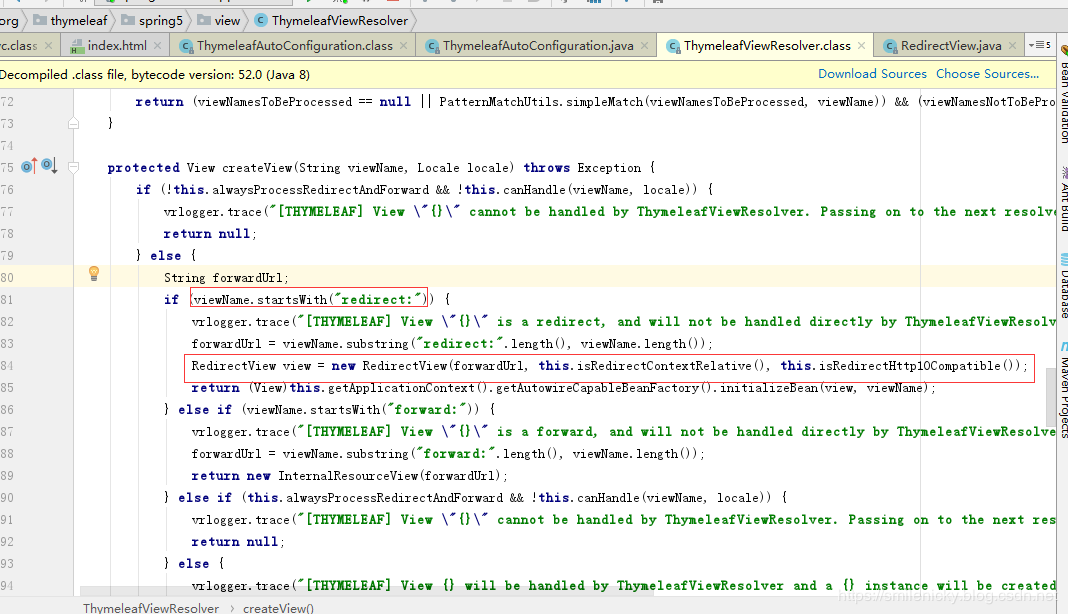
从上面方法可以看出进行重定向或者forward等等方法,然后调一下redirect的,看看RedirectView类,翻下源码,找到如下关键代码:

同样在这个类里,进行了状态码设置,请求头设置,然后response.sendRedirect(encodedURL);
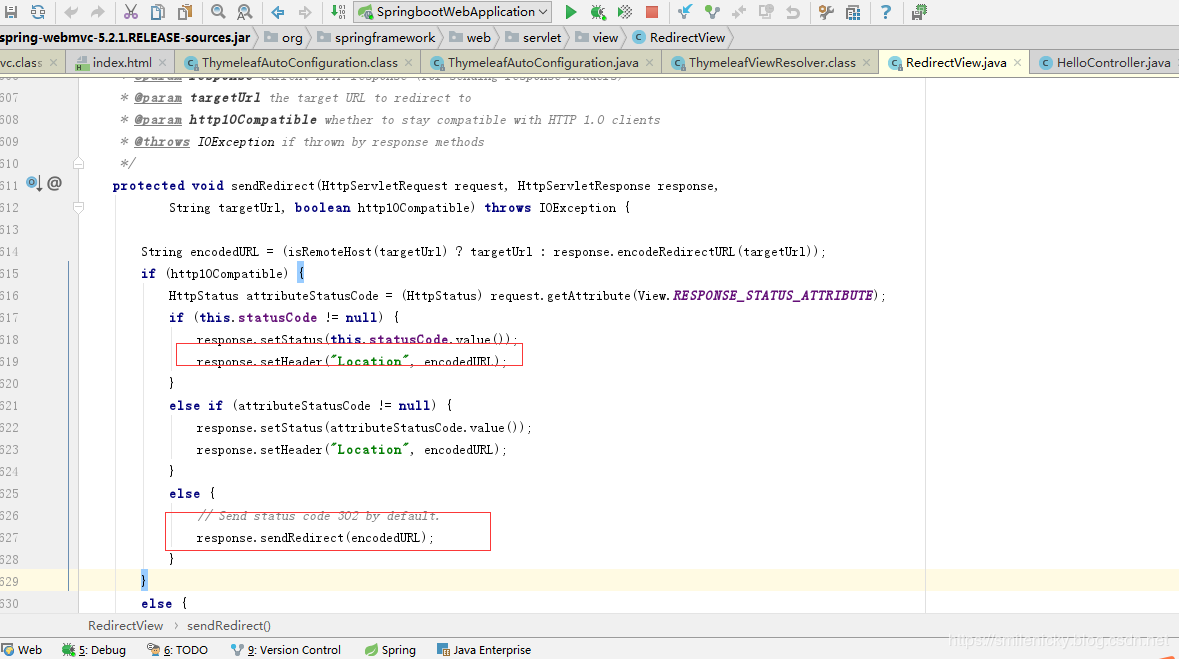
而forward的是通过如图方法进行页面跳转:
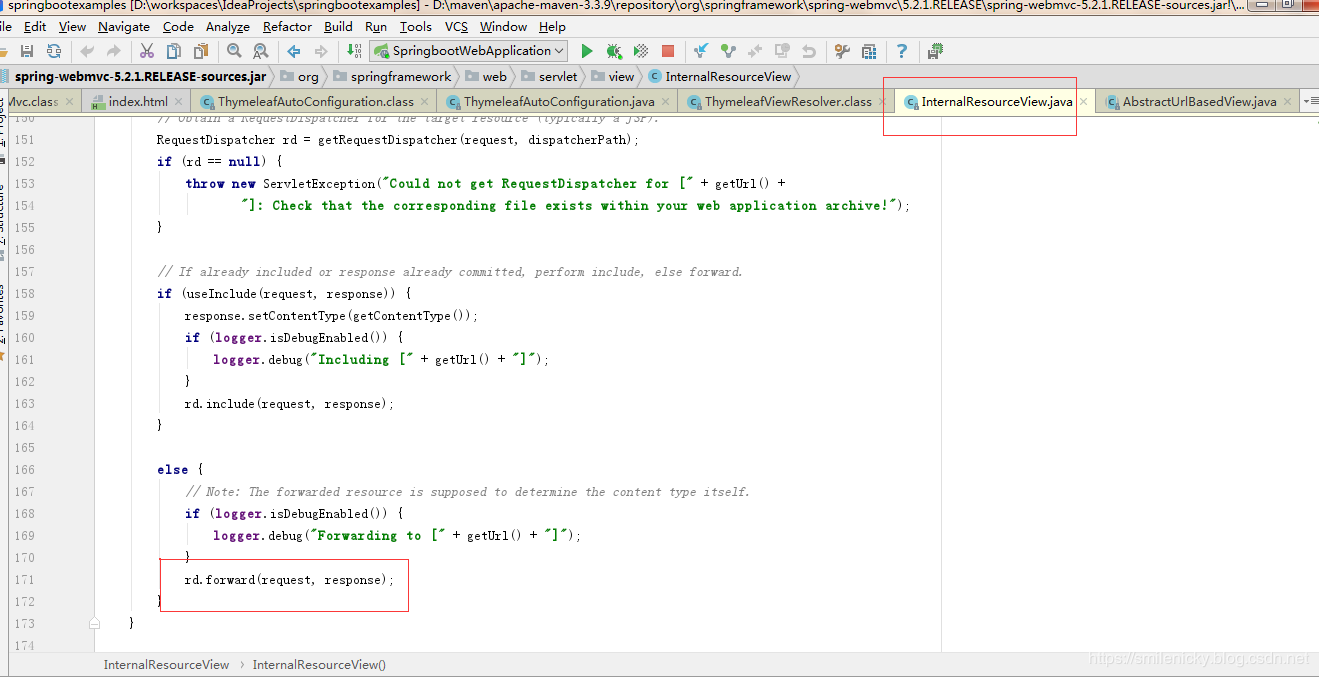
附录:
Thymeleaf官方例子